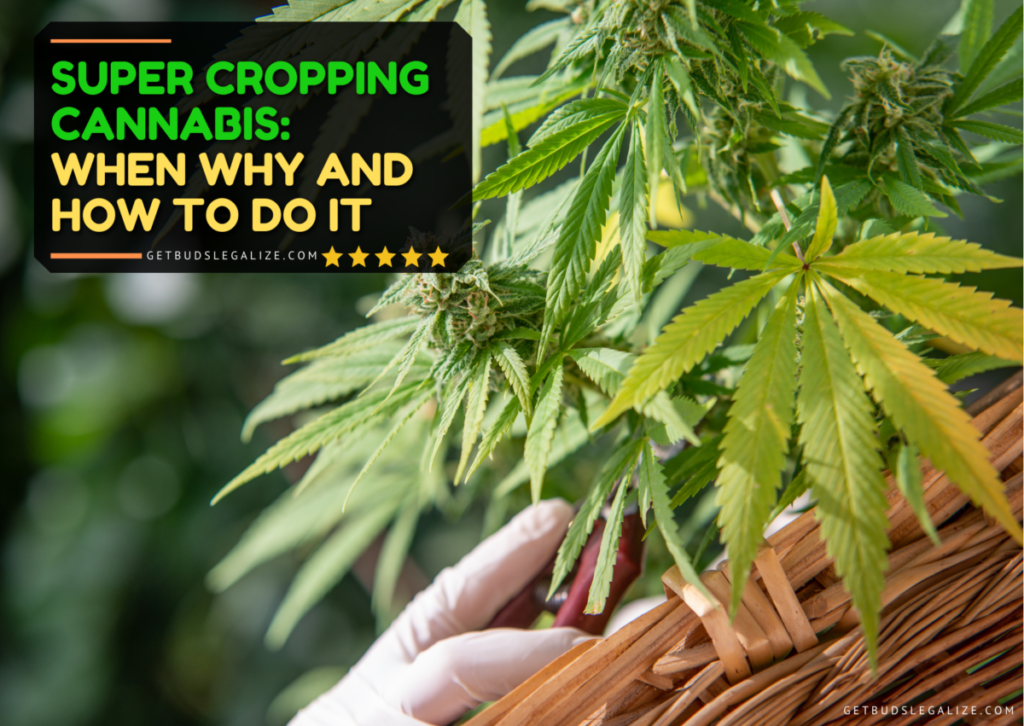Super Cropping Cannabis: When Why and How To Do It
Super cropping cannabis is a simple but effective technique to train your plants and increase their yield and potency. In this blog post, we will explain what super cropping is, what are its benefits and drawbacks, and how to do it properly.
What is Super Cropping?
Super-cropping is a form of high-stress training (HST) that aims to manipulate the growth and development of cannabis plants. Unlike low-stress training (LST), which involves gently bending and tying the stems, super cropping involves applying more pressure and creating slight injuries on the stems. The idea is to weaken the stem enough to make it bend, but not enough to break it completely.
The wounds created by super-cropping trigger a stress response in the plants, which activates their defense mechanisms and survival instincts. The plants produce more auxins, cytokinins, and other hormones that stimulate cell division and tissue repair. The wounds also create knuckles or calluses on the stems, which act as support structures and increase their strength and thickness.
What Are the Benefits and Drawbacks of Super Cropping Cannabis Plants?
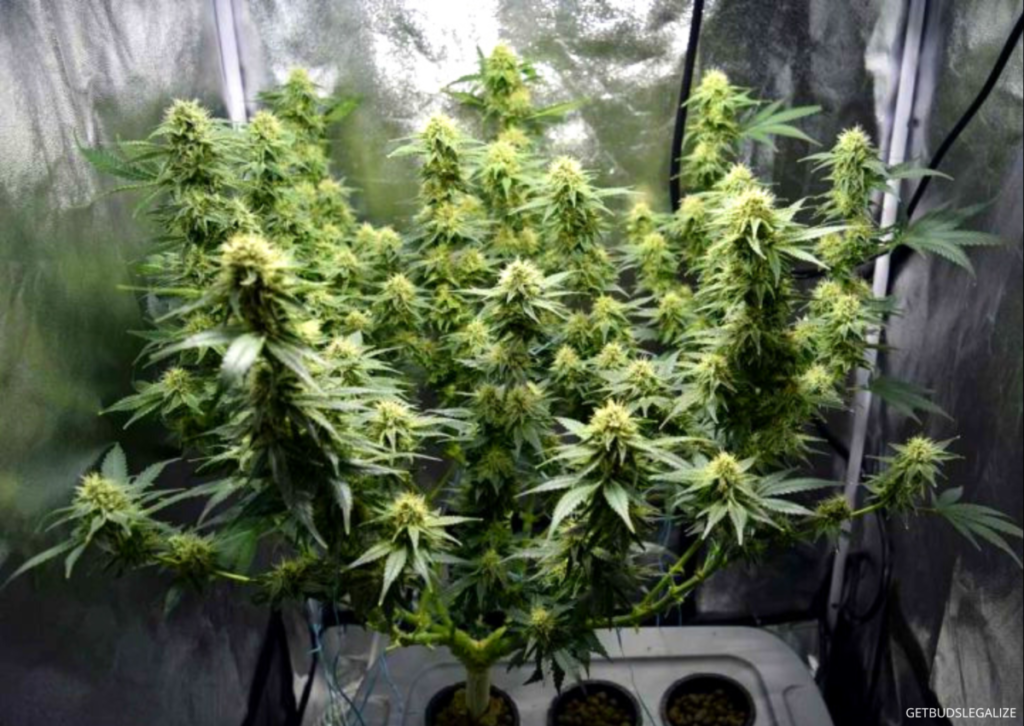
Super-cropping can have several benefits for your plants, but also some drawbacks. Here are some of the pros and cons of super cropping.
Pros:
- It allows you to control the height and shape of your plants, which is especially useful if you have limited space or want to create an even canopy.
- It stimulates the production of more branches and budsites, which can increase your yield and quality.
- It enhances the flow of nutrients and hormones throughout the plant, which can boost its vigor and potency.
- It exposes more parts of the plant to light, which can improve its photosynthesis and resin production.
- Produces stronger branches: This can help them support more weight and resist environmental stress.
Cons:
- It causes stress and damage to your plants, which can make them more vulnerable to pests and diseases if not done correctly or excessively.
- It requires some skill and experience to perform it properly and avoid breaking or snapping the stems.
- It may not work well with some strains or phenotypes that have very rigid or brittle stems.
When to Start Super Cropping?
The best time to super-crop your cannabis growing is during the vegetative stage when your plants are actively growing and developing stems and branches. You should start doing this when your plants are around 30–50cm tall, or when they have at least 4–6 nodes.
You should stop super-cropping at least 2 weeks before switching to the flowering stage, or when you see the first signs of pre-flowers. This will give your plants enough time to heal and focus on producing buds.
You can super-crop your plants once or multiple times, depending on how much you want to manipulate their shape and size. However, you should avoid overdoing it, as too much stress can stunt or damage your plants.
How to Super Crop Cannabis Plants Step-by-Step
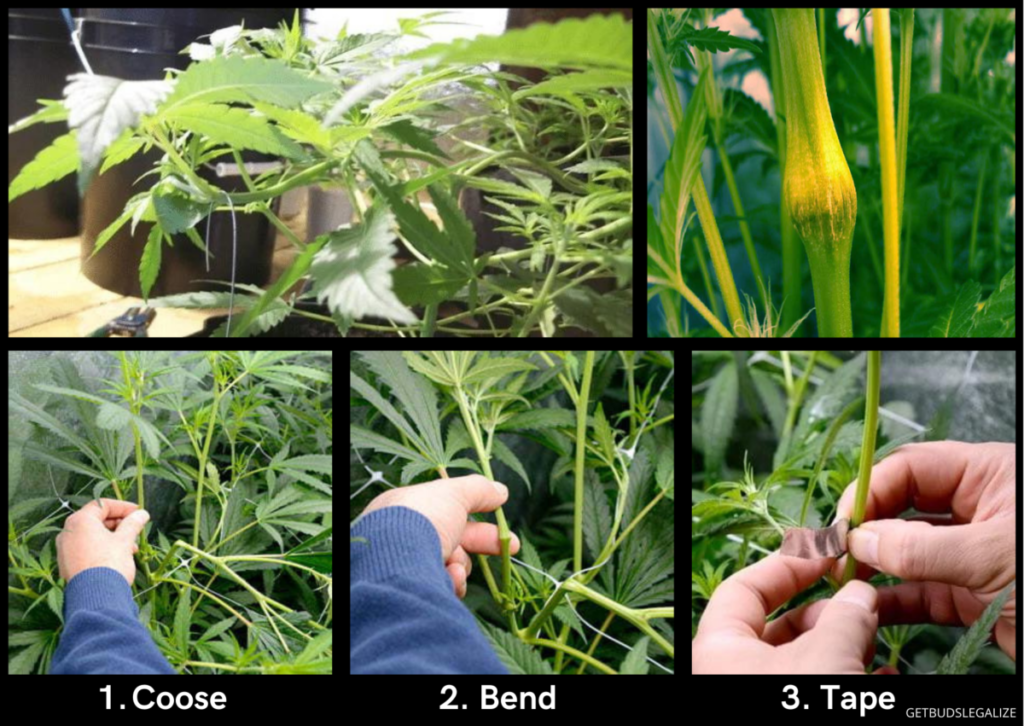
Super-cropping is a very easy technique that anyone can do with minimal effort.
To super crop, you will need:
- Some duct tape or plant ties
- A gentle but firm touch
Here are the steps to follow:
1. Choose a stem that you want to super-crop. It should be healthy, sturdy, and have at least one node above it.
2. Locate the node where you want to bend the stem. It should be about halfway between the base and the tip of the stem.
3. Using your thumb and index finger, gently squeeze and roll the stem back and forth at the node until you feel it soften and weaken. Be careful not to snap or tear the stem.
4. Bend the stem at a 90-degree angle in the direction you want it to grow. You can use duct tape or plant ties to secure it in place if needed.
5. Repeat the process with other stems as desired. You can super-crop multiple stems on the same plant or different plants in your grow space.
6. Monitor your plants for signs of recovery and healing. The stems should form knuckles within a few days or weeks, depending on the strain and growing conditions.
How to Fix Broken Branches
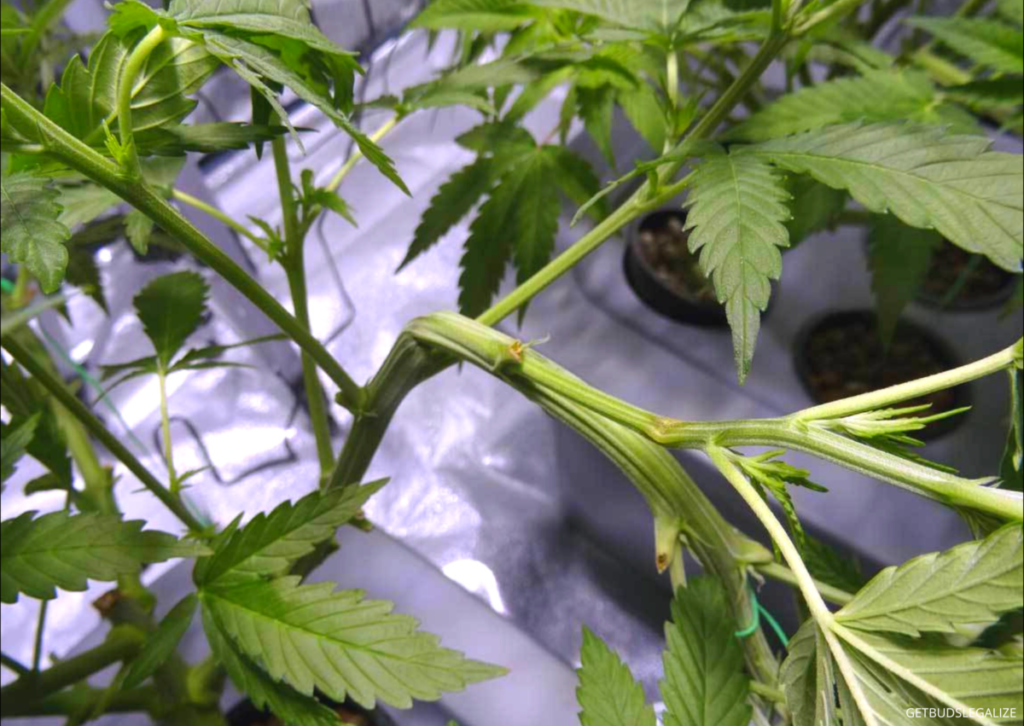
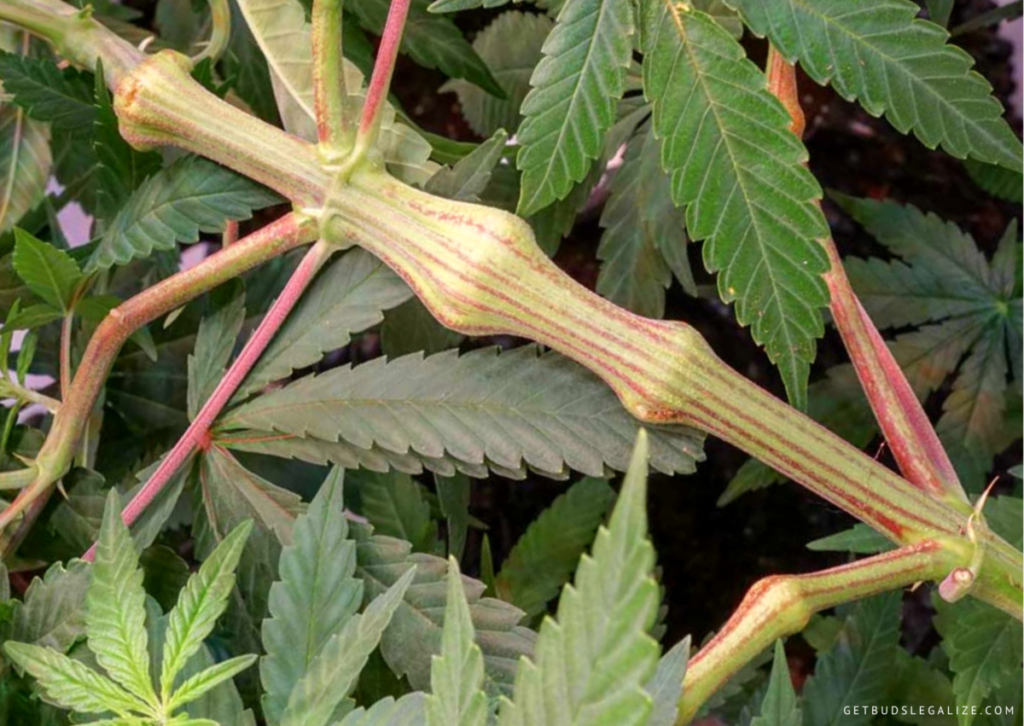
Sometimes, super cropping can go wrong and result in a broken branch. This is not a big deal, as cannabis plants are very resilient and can heal themselves quickly. However, you should act fast and fix any of them as soon as possible to prevent infections or further damage.
Here is a guideline on how to do it correctly:
1. Act quickly: As soon as you notice a broken branch, you should try to repair it as soon as possible. The longer you wait, the lower the chances of recovery.
2. Assess the damage: Depending on how severe the break is, you may need different tools and materials to fix it. If the break is clean and partial, meaning that some tissue is still connecting the two parts of the branch, you may only need some tape or string to hold them together. If the break is complete or jagged, meaning that there is no tissue left between the two parts of the branch, you may need some grafting wax or honey to seal the wound and prevent infection.
3. Clean the wound: Before you attempt to fix the broken branch, you should clean it with some water or alcohol to remove any dirt or debris that may cause infection. You should also trim any dead or damaged tissue around the wound with a sharp knife or scissors.
4. Reconnect the branch: If the break is partial, you should align the two parts of the branch as closely as possible and wrap them with some tape or string. Make sure that the tape or string is tight enough to hold them together but not too tight to cut off circulation. If the break is complete or jagged, you should apply some grafting wax or honey over the wound and press the two parts of the branch together. You may also need some splints or stakes to support the branch until it heals.
5. Monitor the branch: After you fix the broken branch, you should keep an eye on it for signs of recovery or infection. You should also water and feed your plant as usual and avoid stressing it further. If everything goes well, you should see new growth and healing within a few weeks.
What Are Other Plant Training Techniques That You Can Use Along With Super Cropping?
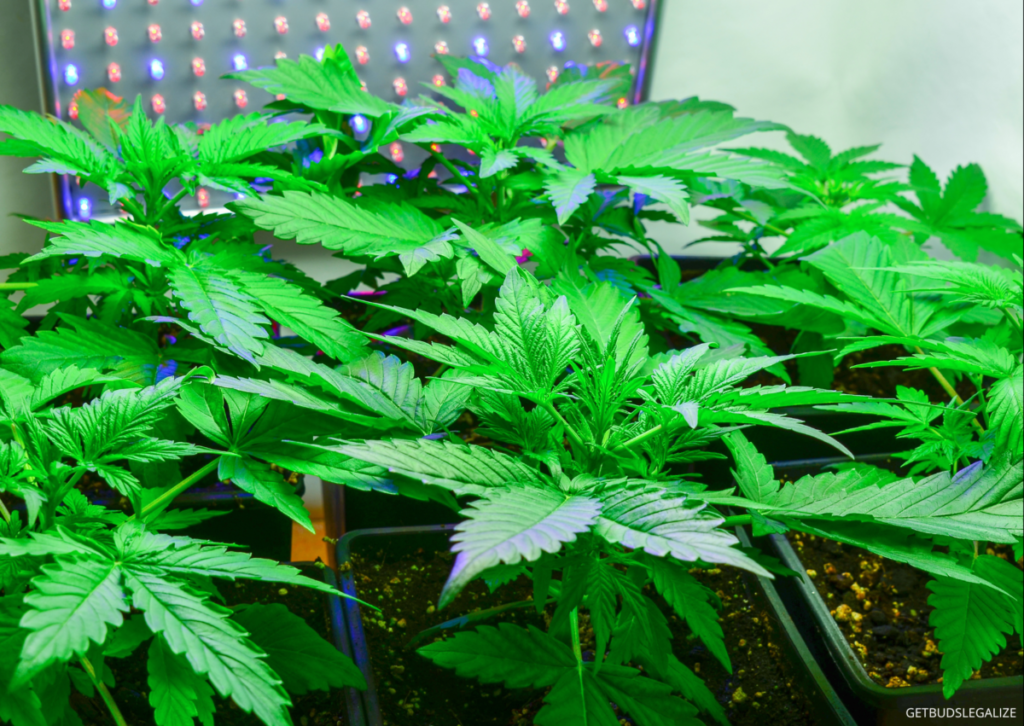
Some other techniques that can be used along with super-cropping are:
- Topping: This is a high stress technique (HST) that involves cutting off the top of the main stem to create two or more main colas instead of one. Topping cannabis can increase the number of bud sites and create a more even canopy. It can also reduce the height of the plant and make it easier to manage.
- Fimming: This is similar to topping, but instead of cutting off the entire top of the stem, only about 75% of it is removed. This creates four or more main colas instead of two. Fimming can produce more buds than topping, but it can also cause more stress to the plant and slow down its growth.
- Lollipopping: This involves removing the lower branches and leaves of the plant that receive little or no light. This allows the plant to focus its energy on the upper buds and improve their quality and size. Lollipopping can also prevent mold and pests from infecting the lower parts of the plant.
- Scrogging: This stands for screen of green, and it involves placing a horizontal net or screen over the plants and weaving their branches through it. This creates a flat and even canopy that maximizes light exposure and space efficiency. Scrogging can increase the yield and quality of the buds, but it requires more time and maintenance than other techniques.
By combining Super-cropping with other stress techniques, you can create a more efficient and productive growing space that will reward you with bigger and better buds. However, it is important to be careful not to overdo it and cause too much stress to the plants, which can have negative effects on their health and productivity.
Here Are Some Tips to Follow for Perfect Success
1• Choose the right branches to super-crop: You want to target mature branches that are flexible and not too woody. Avoid super-cropping young or old branches, as they may not recover well from the stress.
2• Super-crop during the vegetative stage: The best time to super crop your cannabis plants is 3-7 days before switching to the flowering stage. This will give them enough time to heal and adapt to the new shape. Do not super crop during the flowering stage, as this will stunt bud development and lower the quality of your harvest.
3• Pinch and bend gently: To super-crop a branch, you need to squeeze it between your fingers until you feel a slight snap. This means you have broken the inner tissue, but not the outer skin. Then, bend the branch at a 90-degree angle in the direction you want it to grow. Be careful not to tear or split the branch, as this will expose it to infections and pests.
4• Support and secure the branches: After super-cropping, your branches will be weak and droopy. You need to support them with stakes, strings, or zip ties until they recover and form a hard knot at the bend point. This will also help them stay in place and create an even canopy.
5• Monitor and maintain your plants: Super-cropping is a stressful technique that can affect your plants’ health and performance. You need to monitor your plants closely and provide them with optimal conditions for recovery. Make sure they have enough light, water, nutrients, and airflow. You may also apply some bandages or aloe vera gel on the bend points to speed up the healing process.
The Final Result Are Better, Bigger Yields
Super cropping cannabis can be a rewarding technique to use in your grow room when done correctly and with care. It can help you improve your harvest and enjoy your plants more. However, it’s not a magical solution that works for every plant or every grower. You should always experiment with caution and observe how your plants react to different levels of stress. Happy growing!
FAQs
The best time to super-crop your cannabis plants is during the vegetative stage when they are still growing and developing new branches. You can also super-crop during early flowering, but avoid doing it too late as it may affect the bud formation and quality.
To super-crop your cannabis plants, you need to choose a branch that you want to bend and gently squeeze it between your fingers until you hear a soft snap. This means you have broken some of the inner fibers of the stem, but not the outer layer. Then, bend the branch at a 90-degree angle and secure it with some tape or wire. The branch will heal itself and form a knuckle-like joint that will be stronger and thicker than before.
There is no definitive answer to how often you should super-crop your cannabis plants, as it depends on various factors such as the strain, the size, the growth stage, and your personal preference. However, a general rule of thumb is to super-crop once every two weeks during the vegetative stage, and once every four weeks during the early flowering stage. You should also avoid super-cropping too close to harvest time, as it may reduce the quality of your buds.
You can tell if you have super-cropped your cannabis plants correctly by observing their reaction after a few days. If you have done it right, you should see new growth emerging from the bent branches, forming new colas and budsites. You should also see a thickened joint at the bend point, which indicates that the plant has healed itself and become stronger. If you have done it wrong, you may see wilting, yellowing, drooping, or dying branches, which means that you have damaged them too much or caused an infection.
Super-cropping can also have some risks to your cannabis plants if not done properly, such as:
- Damaging or killing the plants by breaking or tearing their stems too much or too often.
- Slowing down or stunting their growth by causing too much stress or shock.
- Inviting infections or diseases by creating wounds that may not heal properly or may attract pathogens.
- Reducing the quality or quantity of buds by affecting their development or maturation.
To avoid or minimize these risks, you should follow some best practices when you do, such as:
- Choosing healthy and vigorous plants that can handle stress better.
- Using clean and sharp tools or your fingers to avoid contamination or injury.
- Applying gentle pressure and bending slowly to avoid snapping or tearing the stems.
- Supporting and securing the bent branches with tape, wire, stakes, or ties to prevent them from falling or breaking further.
- Monitoring and caring for your plants after super cropping by watering, feeding, pruning, and checking for signs of damage or infection.
The recovery time for super-cropping depends on the strain, the severity of the damage, and the environmental conditions, but it usually takes a few days to a week for the stems to heal and resume normal growth.
Super-cropping is a technique that some growers apply when growing autoflowering cannabis seeds. It involves bending the main stem of the plant, which is usually taller and faster growing than the rest of the branches. This way, the main stem remains at a similar level to the other branches, which improves the light distribution and increases yield potential. Super-cropping also helps create a more compact and bushy autoflower, which can be beneficial in limited-height growing spaces.
Super-cropping is a technique that involves bending and slightly damaging the stems of marijuana plants to stress them and encourage more growth. It can be done on any type of cannabis plant, including autos, but it requires some skill and timing to avoid harming the plants too much. Super-cropping can increase yields by creating multiple colas and exposing more budsites to light, but it also slows down the growth and may require more support for the branches.
Monster-cropping is a different technique that involves taking clones from flowering plants and reverting them to the vegetative stage. This creates bushy plants with many branches and nodes that can produce large yields. Monster-cropping can only be done on photoperiod plants, not autos, and it takes longer than super-cropping because the clones need time to root and re-veg.
Both techniques have their pros and cons, and they can be combined for optimal results. However, they should not be done too late in the flowering stage, as this can stress the plants too much and affect the quality and quantity of the buds.
Yes it will. Some growers claim that super-cropping weed can increase yields by up to 40%. Super cropping brings some benefits, such as improving airflow, light penetration, and plant shape.

